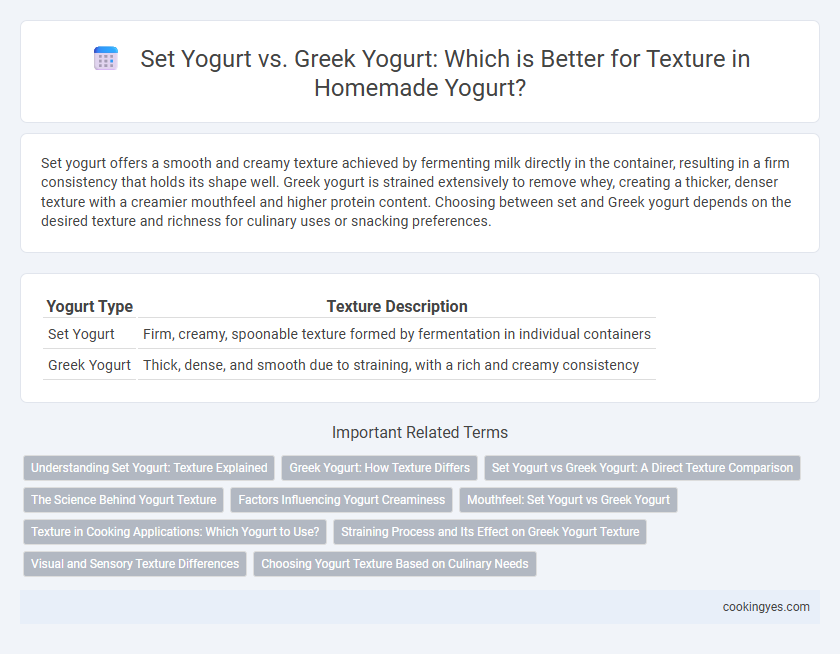Set yogurt offers a smooth and creamy texture achieved by fermenting milk directly in the container, resulting in a firm consistency that holds its shape well. Greek yogurt is strained extensively to remove whey, creating a thicker, denser texture with a creamier mouthfeel and higher protein content. Choosing between set and Greek yogurt depends on the desired texture and richness for culinary uses or snacking preferences.
Table of Comparison
| Yogurt Type | Texture Description |
|---|---|
| Set Yogurt | Firm, creamy, spoonable texture formed by fermentation in individual containers |
| Greek Yogurt | Thick, dense, and smooth due to straining, with a rich and creamy consistency |
Understanding Set Yogurt: Texture Explained
Set yogurt features a firm, gel-like texture achieved through fermentation directly in the serving container, resulting in minimal stirring and a smooth, cohesive consistency. Greek yogurt undergoes straining to remove whey, creating a thicker, creamier texture with higher protein concentration. Understanding these differences highlights set yogurt's delicate firmness versus Greek yogurt's dense, rich creaminess.
Greek Yogurt: How Texture Differs
Greek yogurt features a thicker, creamier texture compared to set yogurt due to the straining process that removes excess whey and liquid. Set yogurt, or pot-set yogurt, has a smooth but softer consistency because it is coagulated directly in the container without straining. The dense texture of Greek yogurt provides a richer mouthfeel and makes it ideal for recipes requiring a firm, creamy base.
Set Yogurt vs Greek Yogurt: A Direct Texture Comparison
Set yogurt features a smooth, creamy texture achieved through fermentation in its container, resulting in a firm yet soft consistency that holds its shape well. Greek yogurt undergoes straining to remove whey, creating a thicker and denser texture with a slightly grainier feel compared to set yogurt. While both offer rich mouthfeel, set yogurt is silkier and more cohesive, whereas Greek yogurt provides a robust, creamy thickness preferred for hearty recipes.
The Science Behind Yogurt Texture
Set yogurt develops its firm, gel-like texture through a slow fermentation process performed directly in the container, allowing a stable casein network to form, which traps water and creates smooth, dense consistency. Greek yogurt undergoes straining to remove whey, concentrating proteins and resulting in a thicker, creamier texture with higher viscosity and reduced moisture content. The difference in texture between set and Greek yogurt is primarily driven by the protein matrix structure and moisture retention influenced by fermentation and straining techniques.
Factors Influencing Yogurt Creaminess
Set yogurt offers a smooth, firm texture due to the traditional fermentation process in individual containers, allowing a dense gel to form. Greek yogurt undergoes straining to remove whey, resulting in a thicker, creamier texture with higher protein concentration. Factors influencing yogurt creaminess include milk fat content, fermentation temperature, and the presence of stabilizers or thickeners.
Mouthfeel: Set Yogurt vs Greek Yogurt
Set yogurt, known for its firm, custard-like texture, offers a smooth and creamy mouthfeel that melts gently on the palate. Greek yogurt, strained extensively to remove whey, presents a thicker, denser texture with a rich, velvety consistency that provides a satisfying, hearty bite. The difference in mouthfeel results from varying straining processes, with set yogurt maintaining a delicate silkiness while Greek yogurt delivers a robust, concentrated creaminess.
Texture in Cooking Applications: Which Yogurt to Use?
Set yogurt offers a firm, custard-like texture that holds its shape well, making it ideal for layered desserts and dips where stability is crucial. Greek yogurt has a thicker, creamier consistency with a slightly grainier feel due to its straining process, providing a rich mouthfeel perfect for creamy sauces and dressings. In cooking applications that require maintaining form under heat, set yogurt is preferred, whereas Greek yogurt excels in recipes needing a smooth, velvety texture.
Straining Process and Its Effect on Greek Yogurt Texture
The straining process removes whey from Greek yogurt, concentrating proteins and resulting in a thicker, creamier texture compared to set yogurt, which retains more liquid and has a softer consistency. Greek yogurt's dense texture is achieved through multiple straining stages, which reduces moisture content and enhances its rich mouthfeel. Set yogurt undergoes minimal filtration, preserving a more fluid texture ideal for traditional uses and desserts.
Visual and Sensory Texture Differences
Set yogurt presents a smooth, firm texture achieved through a slow fermentation process that forms a solid gel structure, resulting in a spoon-stiff consistency without whey separation. Greek yogurt undergoes straining to remove whey, yielding a thicker, creamier texture characterized by dense, velvety mouthfeel and reduced water content. Visually, set yogurt appears glossy and uniform, whereas Greek yogurt shows a denser, more opaque surface with pronounced creaminess and slight graininess.
Choosing Yogurt Texture Based on Culinary Needs
Set yogurt offers a firm, custard-like texture ideal for slicing or layering in desserts, while Greek yogurt is thicker and creamier due to its straining process, making it perfect for dips and sauces. Choosing yogurt texture depends on culinary needs: set yogurt works well in dishes requiring structural integrity, whereas Greek yogurt enhances recipes needing richness and smoothness. Understanding these textural differences helps select the right yogurt to achieve desired consistency and mouthfeel in cooking and baking.
Set yogurt vs Greek yogurt for texture Infographic

 cookingyes.com
cookingyes.com